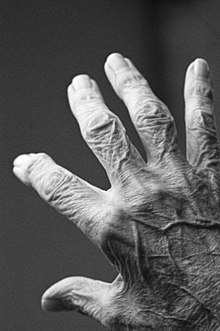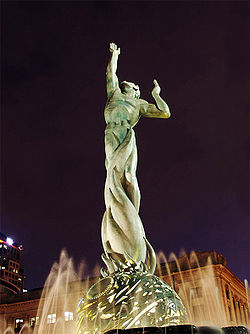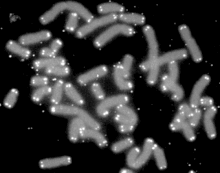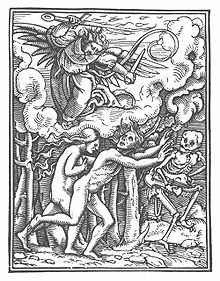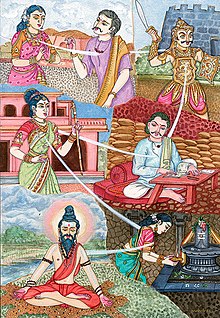The multidisciplinary nature of gerontology means that there are a number of sub-fields which overlap with gerontology. There are policy issues, for example, involved in government planning and the operation of nursing homes, investigating the effects of an ageing population on society, and the design of residential spaces for older people that facilitate the development of a sense of place or home. Dr. Lawton, a behavioral psychologist at the Philadelphia Geriatric Center, was among the first to recognize the need for living spaces designed to accommodate the elderly, especially those with Alzheimer's disease. As an academic discipline the field is relatively new. The USC Leonard Davis School created the first PhD, master's and bachelor's degree programs in gerontology in 1975.
History
In the medieval Islamic world, several physicians wrote on issues related to Gerontology. Avicenna's The Canon of Medicine (1025) offered instruction for the care of the aged, including diet and remedies for problems including constipation.[3] Arabic physician Ibn Al-Jazzar Al-Qayrawani (Algizar, c. 898–980) wrote on the aches and conditions of the elderly (Ammar 1998, p. 4).[4] His scholarly work covers sleep disorders, forgetfulness, how to strengthen memory,[5][6] and causes of mortality[7] Ishaq ibn Hunayn (died 910) also wrote works on the treatments for forgetfulness (U.S. National Library of Medicine, 1994).[8]While the number of aged humans, and the life expectancy, tended to increase in every century since the 14th, society tended to consider caring for an elderly relative as a family issue. It was not until the coming of the Industrial Revolution that ideas shifted in favor of a societal care-system. Some early pioneers, such as Michel Eugène Chevreul, who himself lived to be 102, believed that aging itself should be a science to be studied. Élie Metchnikoff coined the term "gerontology" c. 1903.[9]
Modern pioneers like James Birren began organizing gerontology as its own field in the 1940s, later being involved in starting a US government agency on aging – the National Institute on Aging[10] – programs in gerontology at the University of Southern California and University of California, Los Angeles, and as past president of the Gerontological Society of America (founded in 1945).[11]
With the population of people over 60 years old expected to be some 22% of the world's population by 2050, assessment and treatment methods for age-related disease burden – a multidisciplinary field called geroscience that emerged in the early 21st century – are a frontier for modern medical research on relationships between aging and chronic diseases.[12][13][14]
Aging demographics
The world is forecast to undergo rapid population aging in the next several decades. In 1900, there were 3.1 million people aged 65 years and older living in the United States. However, this population continued to grow throughout the 20th century and reached 31.2, 35, and 40.3 million people in 1990, 2000, and 2010, respectively. Notably, in the United States and across the world, the "baby boomer" generation began to turn 65 in 2011. Recently, the population aged 65 years and older has grown at a faster rate than the total population in the United States. The total population increased by 9.7%, from 281.4 million to 308.7 million, between 2000 and 2010. However, the population aged 65 years and older increased by 15.1% during the same period.[15] It has been estimated that 25% of the population in the United States and Canada will be aged 65 years and older by 2025. Moreover, by 2050, it is predicted that, for the first time in United States history, the number of individuals aged 60 years and older will be greater than the number of children aged 0 to 14 years.[16] Those aged 85 years and older (oldest-old) are projected to increase from 5.3 million to 21 million by 2050.[17] Adults aged 85–89 years constituted the greatest segment of the oldest-old in 1990, 2000, and 2010. However, the largest percentage point increase among the oldest-old occurred in the 90- to 94-year-old age group, which increased from 25.0% in 1990 to 26.4% in 2010.[15]With the rapid growth of the aging population, social work education and training specialized in older adults and practitioners interested in working with older adults are increasingly in demand.[18][19]
Gender differences with age
There has been a considerable disparity between the number of men and women in the older population in the United States. In both 2000 and 2010, women outnumbered men in the older population at every single year of age (e.g., 65 to 100 years and over). The sex ratio, which is a measure used to indicate the balance of males to females in a population, is calculated by taking the number of males divided by the number of females, and multiplying by 100. Therefore, the sex ratio is the number of males per 100 females. In 2010, there were 90.5 males per 100 females in the 65-year-old population. However, this represented an increase from 1990 when there were 82.7 males per 100 females, and from 2000 when the sex ratio was 88.1. Although the gender gap between men and women has narrowed, women continue to have a greater life expectancy and lower mortality rates at older ages relative to men. For example, the Census 2010 reported that there were approximately twice as many women as men living in the United States at 89 years of age (361,309 versus 176,689, respectively).[15]Geographic distribution of older adults
The number and percentage of older adults living in the United States vary across the four different regions (Northeast, Midwest, West, and South) defined by the United States census. In 2010, the South contained the greatest number of people aged 65 years and older and 85 years and older. However, proportionately, the Northeast contains the largest percentage of adults aged 65 years and older (14.1%), followed by the Midwest (13.5%), the South (13.0%), and the West (11.9%). Relative to the Census 2000, all geographic regions demonstrated positive growth in the population of adults aged 65 years and older and 85 years and older. The most rapid growth in the population of adults aged 65 years and older was evident in the West (23.5%), which showed an increase from 6.9 million in 2000 to 8.5 million in 2010. Likewise, in the population aged 85 years and older, the West (42.8%) also showed the fastest growth and increased from 806,000 in 2000 to 1.2 million in 2010. It is worth highlighting that Rhode Island was the only state that experienced a reduction in the number of people aged 65 years and older, and declined from 152,402 in 2000 to 151,881 in 2010. Conversely, all states exhibited an increase in the population of adults aged 85 years and older from 2000 to 2010.[15]Biogerontology
The hand of an older adult
Biogerontology is the sub-field of gerontology concerned with the biological aging process, its evolutionary origins, and potential means to intervene in the process. It involves interdisciplinary research on biological aging's causes, effects, and mechanisms. Conservative biogerontologists such as Leonard Hayflick have predicted that the human life expectancy will peak at about 92 years old,[20] while others such as James Vaupel have predicted that in industrialized countries, life expectancies will reach 100 for children born after the year 2000.[21] and some surveyed biogerontologists have predicted life expectancies of two or more centuries.[22] with Aubrey de Grey offering the "tentative timeframe" that with adequate funding of research to develop interventions in aging such as Strategies for Engineered Negligible Senescence, "we have a 50/50 chance of developing technology within about 25 to 30 years from now that will, under reasonable assumptions about the rate of subsequent improvements in that technology, allow us to stop people from dying of aging at any age", leading to life expectancies of 1,000 years.[23]
Biomedical gerontology, also known as experimental gerontology and life extension, is a sub-discipline of biogerontology that endeavors to slow, prevent, and even reverse aging in both humans and animals. Most "life extensionists" believe the human life span can be increased within the next century, if not sooner. Biogerontologists vary in the degree to which they focus on the study of the aging process as a means of mitigating the diseases of aging or extending lifespan, although most agree that extension of lifespan will necessarily flow from reductions in age-related disease and frailty, although some argue that maximum life span cannot be altered or that it is undesirable to try. Geroscience is a recently-formulated interdisciplinary field that embraces biomedical gerontology as the center of preventing diseases of aging through science emerging at the interface of the biology of aging and age-related disease.[24]
In contrast with biogerontology, which aims to prevent age-related disease by intervening in aging processes, geriatrics is a field of medicine that studies the treatment of existing disease in aging people.
Biological theories of aging
There are numerous theories of aging, and no one theory has been accepted. There is a wide spectrum of the types of theories for the causes of aging with programmed theories on one extreme and error theories on the other. Regardless of the theory, a commonality is that as humans age, functions of the body decline.[16]Stochastic theories of aging (STA)
Stochastic theories of aging is the suggestion that aging is caused by small changes in the body over time and the body's failure to restore the system and mend the damages to the body. The cells and tissues are eventually injured due to the damage gathered over time. This causes the diminishes in an organ's function related to age. The notion of accumulated damage was first introduced by Weisman as the "wear and tear" theory.[25]Wear and tear theory
Wear and tear theories of aging suggest that as an individual ages, body parts such as cells and organs wear out from continued use. Wearing of the body can be attributable to internal or external causes that eventually lead to an accumulation of insults which surpasses the capacity for repair. Due to these internal and external insults, cells lose their ability to regenerate, which ultimately leads to mechanical and chemical exhaustion. Some insults include chemicals in the air, food, or smoke. Other insults may be things such as viruses, trauma, free radicals, cross-linking, and high body temperature.[16]Accumulation
Accumulation theories of aging suggest that aging is bodily decline that results from an accumulation of elements, whether introduced to the body from the environment or resulting from cell metabolism.[16] An example of an accumulation theory is the Free Radical Theory of Aging.The free radical theory of aging
Free radicals are reactive molecules produced by cellular and environmental processes, and can damage the elements of the cell such as the cell membrane and DNA and cause irreversible damage. The free-radical theory of aging proposes that this damage cumulatively degrades the biological function of cells and impacts the process of aging.[26] The idea that free radicals are toxic agents was first proposed by Rebeca Gerschman and colleagues in 1945,[27] but came to prominence in 1956, when Denham Harman proposed the free-radical theory of aging and even demonstrated that free radical reactions contribute to the degradation of biological systems.[28] Oxidative damage of many types accumulate with age, such as oxidative stress that oxygen-free radicals,[29] because the free radical theory of aging argues that aging results from the damage generated by reactive oxygen species (ROS).[30] ROS are small, highly reactive, oxygen-containing molecules that can damage a complex of cellular components such as fat, proteins, or from DNA, they are naturally generated in small amounts during the body's metabolic reactions. These conditions become more common as we age, including diseases related to aging, such as dementia, cancer and heart disease.The DNA damage theory of aging
DNA damage has been one of the many causes in diseases related to aging. The stability of the genome is defined by the cells machinery of repair, damage tolerance, and checkpoint pathways that counteracts DNA damage. One hypothesis proposed by Gioacchino Failla in 1958[31] is that damage accumulation to the DNA causes aging. The hypothesis was developed soon by physicist Leó Szilárd.[32] This theory has changed over the years as new research has discovered new types of DNA damage and mutations, and several theories of aging argue that DNA damage with or without mutations causes aging.[33]The cross-linking theory of aging
The cross-linking theory proposes that advanced glycation end-products (stable bonds formed by the binding of glucose to proteins) and other aberrant cross-links accumulating in aging tissues is the cause of aging. The crosslinking of proteins disables their biological functions. The hardening of the connective tissue, kidney diseases, and enlargement of the heart are connected to the cross-linking of proteins. Crosslinking of DNA can induce replication errors, and this leads to deformed cells and increases the risk of cancer.[25]Genetic
Genetic theories of aging propose that aging is programmed within each individual's genes. According to this theory, genes dictate cellular longevity. Programmed cell death, or apoptosis, is determined by a "biological clock" via genetic information in the nucleus of the cell. Genes responsible for apoptosis provide an explanation for cell death, but are less applicable to death of an entire organism. An increase in cellular apoptosis may correlate to aging, but is not a 'cause of death'. Environmental factors and genetic mutations can influence gene expression and accelerate aging. More recently epigenetics have been explored as a contributing factor. The epigenetic clock, which objectively measures the biological age of cells and tissues, may become useful for testing different biological aging theories.[34]General imbalance
General imbalance theories of aging suggest that body systems, such as the endocrine, nervous, and immune systems, gradually decline and ultimately fail to function. The rate of failure varies system by system.[16]Immunological theory of aging
The immunological theory of aging suggests that the immune system weakens as an organism ages. This makes the organism unable to fight infections and less able to destroy old and neoplastic cells. This leads to aging and will eventually lead to death. This theory of aging was developed by Ray Walford, an American gerontologist. According to Walford, incorrect immunological procedures are the cause of the process of aging.[26]Social gerontology
Social gerontology is a multi-disciplinary sub-field that specializes in studying or working with older adults. Social gerontologists may have degrees or training in social work, nursing, psychology, sociology, demography, public health, or other social science disciplines. Social gerontologists are responsible for educating, researching, and advancing the broader causes of older people.Because issues of life span and life extension need numbers to quantify them, there is an overlap with demography. Those who study the demography of the human life span differ from those who study the social demographics of aging.
Social theories of aging
Several theories of aging are developed to observe the aging process of older adults in society as well as how these processes are interpreted by men and women as they age.[35]Activity theory
Activity theory was developed and elaborated by Cavan, Havighurst, and Albrecht. According to this theory, older adults' self-concept depends on social interactions. In order for older adults to maintain morale in old age, substitutions must be made for lost roles. Examples of lost roles include retirement from a job or loss of a spouse.[35]Activity is preferable to inactivity because it facilitates well-being on multiple levels. Because of improved general health and prosperity in the older population, remaining active is more feasible now than when this theory was first proposed by Havighurst nearly six decades ago. The activity theory is applicable for a stable, post-industrial society, which offers its older members many opportunities for meaningful participation.Weakness: Some aging persons cannot maintain a middle-aged lifestyle, due to functional limitations, lack of income, or lack of a desire to do so. Many older adults lack the resources to maintain active roles in society. On the flip side, some elders may insist on continuing activities in late life that pose a danger to themselves and others, such as driving at night with low visual acuity or doing maintenance work to the house while climbing with severely arthritic knees. In doing so, they are denying their limitations and engaging in unsafe behaviors.[36]
Disengagement theory
Disengagement theory was developed by Cumming and Henry. According to this theory, older adults and society engage in a mutual separation from each other. An example of mutual separation is retirement from the workforce. A key assumption of this theory is that older adults lose "ego-energy" and become increasingly self-absorbed. Additionally, disengagement leads to higher morale maintenance than if older adults try to maintain social involvement. This theory is heavily criticized for having an escape clause - namely, that older adults who remain engaged in society are unsuccessful adjusters to old age.[35]Gradual withdrawal from society and relationships preserves social equilibrium and promotes self-reflection for elders who are freed from societal roles. It furnishes an orderly means for the transfer of knowledge, capital, and power from the older generation to the young. It makes it possible for society to continue functioning after valuable older members die.
Continuity theory
Continuity theory is an elusive concept. On one hand, to exhibit continuity can mean to remain the same, to be uniform, homogeneous, unchanging, even humdrum. This static view of continuity is not very applicable to human aging. On the other hand, a dynamic view of continuity starts with the idea of a basic structure which persists over time, but it allows for a variety of changes to occur within the context provided by the basic structure. The basic structure is coherent: It has an orderly or logical relation of parts that is recognizably unique and that allows us to differentiate that structure from others. With the introduction of the concept of time, ideas such as direction, sequence, character development, and story line enter into the concept of continuity as it is applied to the evolution of a human being. In this theory, a dynamic concept of continuity is developed and applied to the issue of adaptation to normal aging.[37]A central premise of continuity theory is that, in making adaptive choices, middle-aged and older adults attempt to preserve and maintain existing internal and external structures and that they prefer to accomplish this objective by using continuity (i.e., applying familiar strategies in familiar arenas of life). In middle and later life, adults are drawn by the weight of past experience to use continuity as a primary adaptive strategy for dealing with changes associated with normal aging. To the extent that change builds upon, and has links to, the person's past, change is a part of continuity. As a result of both their own perceptions and pressures from the social environment, individuals who are adapting to normal aging are both predisposed and motivated toward inner psychological continuity as well as outward continuity of social behavior and circumstances.[38]
Continuity theory views both internal and external continuity as robust adaptive strategies that are supported by both individual preference and social sanctions. Continuity theory consists of general adaptive principles that people who are normally aging could be expected to follow, explanations of how these principles work, and a specification of general areas of life in which these principles could be expected to apply. Accordingly, continuity theory has enormous potential as a general theory of adaptation to individual aging.[39]
Age stratification theory
According to this theory, older adults born during different time periods form cohorts that define "age strata". There are two differences among strata: chronological age and historical experience. This theory makes two arguments. 1. Age is a mechanism for regulating behavior and as a result determines access to positions of power. 2. Birth cohorts play an influential role in the process of social change.[35]Life course theory
According to this theory, which stems from the Life Course Perspective (Bengston and Allen, 1993),[40] aging occurs from birth to death. Aging involves social, psychological, and biological processes. Additionally, aging experiences are shaped by cohort and period effects.[35]Also reflecting the life course focus, consider the implications for how societies might function when age-based norms vanish—a consequence of the deinstitutionalization of the life course— and suggest that these implications pose new challenges for theorizing aging and the life course in postindustrial societies. Dramatic reductions in mortality, morbidity, and fertility over the past several decades have so shaken up the organization of the life course and the nature of educational, work, family, and leisure experiences that it is now possible for individuals to become old in new ways. The configurations and content of other life stages are being altered as well, especially for women. In consequence, theories of age and aging will need to be reconceptualized.[41]
Cumulative advantage/disadvantage theory
According to this theory, which was developed beginning in the 1960s by Derek Price and Robert Merton and elaborated on by several researchers such as Dale Dannefer,[42] inequalities have a tendency to become more pronounced throughout the aging process. A paradigm of this theory can be expressed in the adage "the rich get richer and the poor get poorer". Advantages and disadvantages in early life stages have a profound effect throughout the life span. However, advantages and disadvantages in middle adulthood have a direct influence on economic and health status in later life.[35]Environmental gerontology
Environmental gerontology is a specialization within gerontology that seeks an understanding and interventions to optimize the relationship between aging persons and their physical and social environments.[43][44][45]The field emerged in the 1930s during the first studies on behavioral and social gerontology. In the 1970s and 1980s, research confirmed the importance of the physical and social environment in understanding the aging population and improved the quality of life in old age.[46] Studies of environmental gerontology indicate that older people prefer to age in their immediate environment, whereas spatial experience and place attachment are important for understanding the process.[47]
Some research indicates that the physical-social environment is related to the longevity and quality of life of the elderly. Precisely, the natural environment (such as natural therapeutic landscapes, therapeutic garden) contributes to active and healthy aging in the place.[48][49]
